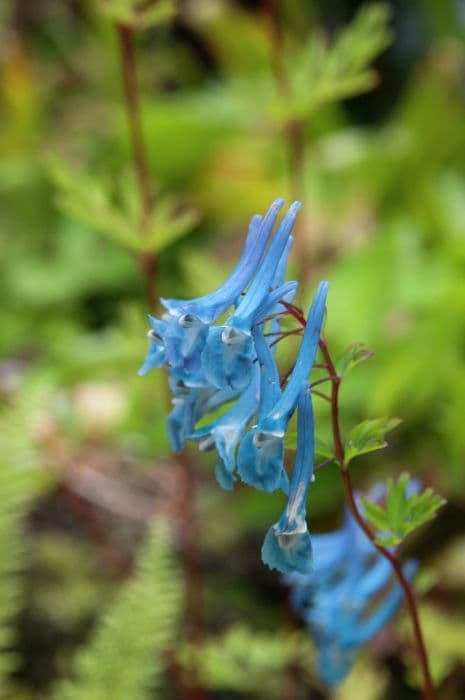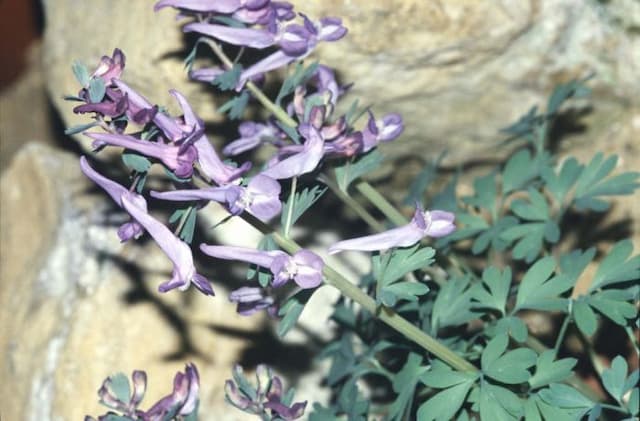Oriental Poppy Papaver (Oriental Group) 'Prinzessin Victoria Louise'

ABOUT
The Papaver 'Prinzessin Victoria Louise', commonly known as Oriental poppy, boasts large, showy flowers that are a feast for the eyes. The blooms are an enchanting soft salmon-pink, with petals that resemble delicate silk yet have a robust texture. Each petal has a black blotch at the base, which adds a striking contrast to their light hue. At the center of the flower, a cluster of dark purple stamens circle a central ovary, drawing pollinators and admirers alike. The foliage of the Oriental poppy is equally distinctive with its bristly texture. The leaves are deeply lobed, presenting a rich green color that can appear slightly grayish due to a subtle covering of fine hairs. This creates a lush, almost fern-like backdrop for the dazzling flowers. Once the flowering season concludes, the Oriental poppy produces unique seed pods. These pods are an intriguing feature in the garden, adding structural interest even after the petals have fallen. Overall, the 'Prinzessin Victoria Louise' Oriental poppy is a plant that is celebrated for its captivating blooms and its ability to bring a touch of elegance and vibrancy to any garden setting. The flower's appearance, with its exquisite coloration and contrasting features, can be a centerpiece in garden designs during its peak blooming period.
About this plant
 Names
NamesSynonyms
Oriental Poppy, Princess Victoria Louise Poppy.
Common names
Papaver orientale 'Prinzessin Victoria Louise'
 Toxicity
ToxicityTo humans
Oriental poppy is not typically considered highly toxic to humans. However, as with many plants, it can cause gastrointestinal upset if ingested in large quantities. Since it is a member of the Papaveraceae family, it contains alkaloids that may act on the central nervous system, but the concentration of these compounds is generally low in ornamental poppies compared to their opium-producing relatives. The sap may cause skin irritation in susceptible individuals. It is advisable to exercise caution and keep the plant out of reach of children who might be tempted to ingest it. Symptoms of ingestion can include nausea, vomiting, and diarrhea. In case of contact with the sap, skin irritation such as redness, itching, and swelling may occur.
To pets
Oriental poppy can cause mild to moderate toxicity in pets if ingested. While it does not contain the same level of opiates found in opium poppies, it does have other alkaloids that can cause gastrointestinal upset, including vomiting and diarrhea, if eaten in large amounts. Additionally, the foliage and sap can be irritants, potentially causing drooling, pawing at the face, or other signs of discomfort if they come into contact with your pet's mouth or skin. It is best to keep pets away from this plant and seek veterinary attention if you suspect they have consumed a significant amount.
 Characteristics
CharacteristicsLife cycle
Perennials
Foliage type
Deciduous
Color of leaves
Green
Flower color
Salmon-pink
Height
2-3 feet (60-90 cm)
Spread
1-2 feet (30-60 cm)
Plant type
Herb
Hardiness zones
3-7
Native area
Caucasus, Northeastern Turkey, Northern Iran
Benefits
 General Benefits
General Benefits- Attracts Pollinators: Serves as a nectar source for bees and other beneficial insects, which can help pollinate surrounding plants.
- Low Maintenance: Once established, it requires minimal care, saving time and resources for gardeners.
- Drought Tolerant: Adapts well to dry conditions, making it suitable for water-wise gardens.
- Decorative Blooms: Features large, colorful flowers that can enhance the visual appeal of any garden or landscape.
- Resistant to Deer and Rabbits: Typically avoided by deer and rabbits, reducing the risk of damage from wildlife.
 Medical Properties
Medical PropertiesThis plant is not used for medical purposes.
 Air-purifying Qualities
Air-purifying QualitiesThis plant is not specifically known for air purifying qualities.
 Other Uses
Other Uses- Oriental poppies can be used as a natural fabric dye, providing a range of colors from orange to deep red depending on the mordant used.
- The petals of the oriental poppy are sometimes used in potpourri mixes, contributing a vivid color and subtle fragrance to the mixture.
- The seeds of the oriental poppy, though not as commonly used as those from Papaver somniferum, can be used in baking for their flavor and texture.
- Dried seed pods of the oriental poppy can be incorporated into flower arrangements and crafts for their interesting shape and structure.
- Livestock, particularly sheep, can safely graze on oriental poppies as they are non-toxic to them, unlike some other poppy species.
- Oriental poppies can be used in companion planting to deter pests in the garden, as their strong scent and toxic properties are unappealing to many insects.
- The vibrant blooms are used for ornamental purposes, such as decorating cakes or as delicate accents in ice cubes for fancy drinks.
- As a winter-hardy plant, cultivating oriental poppies can help prevent soil erosion in gardens and landscapes during the dormant season.
- Oriental poppy plants are sometimes used in educational settings to demonstrate basic principles of plant biology and the life cycle of perennials.
- Artists and photographers often utilize oriental poppies as subjects in their work due to their striking appearance and the challenge they pose for capturing their delicate petals.
Interesting Facts
 Feng Shui
Feng ShuiOriental Poppy is not used in Feng Shui practice.
 Zodiac Sign Compitability
Zodiac Sign CompitabilityOriental Poppy is not used in astrology practice.
 Plant Symbolism
Plant Symbolism- Remembrance: Poppies are widely recognized as a symbol of remembrance, particularly for those who have died in war. This association is especially strong due to the poem "In Flanders Fields" and poppies' prevalence in disturbed earth of battlefields.
- Peace: In the aftermath of conflict, poppies can also symbolize a desire for peace and the end of war, as they often grow on battle-scarred grounds once peace is restored.
- Death: Due to their blood-red color and aforementioned association with war, poppies can represent death and the notion of eternal sleep.
- Resilience and Hope: Despite their delicate appearance, poppies are hardy flowers that can grow in difficult conditions, symbolizing resilience and the hope of life prevailing through hardship.
- Beauty and Success: The eye-catching nature of the 'Prinzessin Victoria Louise' poppy, with its beautiful salmon-pink petals, can symbolize beauty and success, as well as a celebration of life's vibrant moments.
- Sleep and Oblivion: The opium derived from some species of poppies has been used to induce sleep and forgetfulness of pain, making the poppy a symbol for sleep and the blissful ignorance of oblivion.
- Extravagance: Given the lush, ornate blossoms of the 'Prinzessin Victoria Louise' poppy, they can represent extravagance and a luxurious sense of abundance.
 Water
WaterOriental poppies like 'Prinzessin Victoria Louise' prefer to be watered deeply and then allowed to dry out between waterings. Water them once a week with about 1 to 1.5 gallons of water per plant, ensuring the soil is thoroughly moistened but not waterlogged. During hot, dry spells, they may need additional water, but overwatering can lead to root rot, so always check the moisture level of the soil before watering again. Reduce watering in the fall as the plant goes dormant, and provide minimal water during the winter if the soil is extremely dry.
 Light
LightOriental poppies, including 'Prinzessin Victoria Louise', thrive in full sun, where they can receive at least 6 to 8 hours of direct sunlight daily. Plant them in a location where they can bask in the morning light and are protected from the intense heat of the late afternoon sun in very hot climates. Adequate sun exposure ensures the best flowering and plant vigor.
 Temperature
TemperatureOriental poppies such as 'Prinzessin Victoria Louise' can survive in a range of temperatures but grow best when daytime temperatures are between 60°F and 75°F. These plants are hardy in USDA zones 3 to 7 and can endure winter temperatures down to -40°F. During summer, they can withstand temporary highs up to 95°F, but prolonged heat can stress them.
 Pruning
PruningPruning of 'Prinzessin Victoria Louise' Oriental poppies is mainly focused on deadheading spent flowers to encourage additional blooming and to maintain a tidy appearance. After blooming, cut back the flower stems but leave the foliage, which will continue to gather energy for the plant until it dies back in late summer. Cut the foliage to the ground in fall as the plant enters dormancy.
 Cleaning
CleaningAs needed
 Soil
SoilOriental Poppy 'Prinzessin Victoria Louise' thrives in well-draining, fertile soil with a neutral to slightly alkaline pH of 6.5-7.5; mix garden soil with compost and sand for best results.
 Repotting
RepottingOriental Poppies, including 'Prinzessin Victoria Louise', are not typically repotted as they are perennials that prefer to remain undisturbed.
 Humidity & Misting
Humidity & MistingOriental Poppy 'Prinzessin Victoria Louise' is tolerant of average humidity levels and does not require special humidity conditions to thrive.
 Suitable locations
Suitable locationsIndoor
Place in a sunny spot with good airflow and well-draining soil.
Outdoor
Full sun, well-draining soil, and protect from strong winds.
Hardiness zone
3-9 USDA.
 Life cycle
Life cycleOriental Poppy 'Prinzessin Victoria Louise' begins its life cycle with seed germination, which occurs in late spring or early summer, after experiencing the stratification period required to break seed dormancy. The seedlings develop their first true leaves and establish a small rosette of foliage, which becomes dormant during the heat of the summer. In the following spring, the rosette enlarges and the plant enters a vegetative growth stage, forming a larger clump with deep taproots. This perennial then produces tall flowering stems bearing large, showy blossoms in late spring to early summer, with colors ranging from salmon-pink to orange. After flowering, the plant sets seed and the foliage begins to wither away as the plant enters a period of dormancy during the hot summer months. The plant survives the winter as a root system, ready to regenerate its foliage in the next spring and repeat the cycle.
 Propogation
PropogationPropogation time
Spring to Summer
Propogation: The Papaver orientale 'Prinzessin Victoria Louise', commonly known as Oriental Poppy, is best propagated by seed. The optimal time for sowing seeds is in late fall or early spring when the soil is workable. To propagate, prepare a seedbed by loosening the soil and ensuring good drainage. Scatter the seeds thinly over the prepared area and cover them lightly with soil, as poppy seeds require light to germinate. Keep the soil moist but not waterlogged. In spring, the seeds will germinate, and the seedlings can be thinned to about 6 to 8 inches (15 to 20 centimeters) apart to give the plants room to grow. Oriental Poppies are long-lived perennials, and although they may take a year to establish fully, they will return to the garden each year with proper care.









